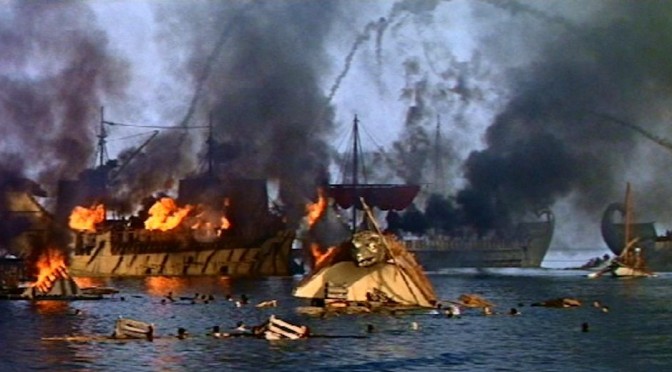Agrippa
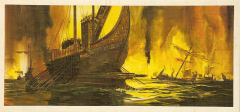 Figure 1 The battle of Actium. Octavian defeats Anthony and Cleopatra.When Octavian declared war on Anthony, it was all or nothing. In the agreement with Anothony he had acquired the whole of the celtic territories wheras Antony had acquired the east. Octavian had done nothing to demonstrate his suitability as “high king” and it was known that the commander of his army was Vispanius Agrippa. In the meantime despite reverses in battle with the Parthians, Antony had captured Armenia, forcing Parthia to the east and establishing a valuable buffer state.Octavian, again using Aggrippa as his commander in the field attacked Anthony in Greece and defeated him in a sea battle at Actium. His success however, if anything, emphasised the differences between east and west.
Figure 1 The battle of Actium. Octavian defeats Anthony and Cleopatra.When Octavian declared war on Anthony, it was all or nothing. In the agreement with Anothony he had acquired the whole of the celtic territories wheras Antony had acquired the east. Octavian had done nothing to demonstrate his suitability as “high king” and it was known that the commander of his army was Vispanius Agrippa. In the meantime despite reverses in battle with the Parthians, Antony had captured Armenia, forcing Parthia to the east and establishing a valuable buffer state.Octavian, again using Aggrippa as his commander in the field attacked Anthony in Greece and defeated him in a sea battle at Actium. His success however, if anything, emphasised the differences between east and west.
Three empires
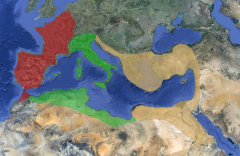 Fig 2 Hellenic,(Fawn) Celtic (Red) and Rebublican(Green) empires.Thus Rome found itself with three empires. In the West, where the peoples of the empire were predominantly Celtic, the High King was a personal not institutional position. In the east the various client kings were the main instruments of the state. The role of the emperor was one of educating, cajoling and occasionally disciplining the kings into compliance. In the middle was the old Roman Republic, still responding to the senate, not the emperor. The dividing line between these three empires was somewhere in Illyria so it is not surprising that the Illyrians found the strategies and initiatives most difficult to understand. Gradually the Hellenistic states came to believe that the Emperor of Rome was the rightful leader of their extended family. Some had to be “pursuaded” to give up their independance but the kings of both Pergamon and Bythnia,at their death bequeathed their nation to Roman rule. In the West is was, from the very beginning, very different.
Fig 2 Hellenic,(Fawn) Celtic (Red) and Rebublican(Green) empires.Thus Rome found itself with three empires. In the West, where the peoples of the empire were predominantly Celtic, the High King was a personal not institutional position. In the east the various client kings were the main instruments of the state. The role of the emperor was one of educating, cajoling and occasionally disciplining the kings into compliance. In the middle was the old Roman Republic, still responding to the senate, not the emperor. The dividing line between these three empires was somewhere in Illyria so it is not surprising that the Illyrians found the strategies and initiatives most difficult to understand. Gradually the Hellenistic states came to believe that the Emperor of Rome was the rightful leader of their extended family. Some had to be “pursuaded” to give up their independance but the kings of both Pergamon and Bythnia,at their death bequeathed their nation to Roman rule. In the West is was, from the very beginning, very different.
The Celtic Initiative
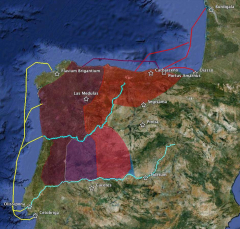 Fig 3 Octavian's capture of Cantabria( North- West Hispania) showing Octavian's personal command (yellow)It is no coincidence that Celtic assimilation with Rome and the acceptance of Roman Government improved from the point at which in 27 BC Octavian became Augustus, the sole ruler, Emperor of Rome. In theory there was no longer confusion about who was High King and wether the High King had earned his status. However in Celtic eyes any new emperor had to prove himself as High King. The Celts had waited and watched. The Hispanic Celts soon got to know Octavian well. He had served with Julius Caesar in Southern Hispania, but now he proved himself beyond doubt. In 26 BC he led the Romans in the Cantabrian war as a result of which the Romans finally controlled the whole of the Spanish Peninsula.It was breathtaking in its scope using co-ordinated attacks on land and by sea. His prize was the mines of Cantabria; Las Medulas , rich in gold and the basque coast rich in Iron.
Fig 3 Octavian's capture of Cantabria( North- West Hispania) showing Octavian's personal command (yellow)It is no coincidence that Celtic assimilation with Rome and the acceptance of Roman Government improved from the point at which in 27 BC Octavian became Augustus, the sole ruler, Emperor of Rome. In theory there was no longer confusion about who was High King and wether the High King had earned his status. However in Celtic eyes any new emperor had to prove himself as High King. The Celts had waited and watched. The Hispanic Celts soon got to know Octavian well. He had served with Julius Caesar in Southern Hispania, but now he proved himself beyond doubt. In 26 BC he led the Romans in the Cantabrian war as a result of which the Romans finally controlled the whole of the Spanish Peninsula.It was breathtaking in its scope using co-ordinated attacks on land and by sea. His prize was the mines of Cantabria; Las Medulas , rich in gold and the basque coast rich in Iron.
Revolt in Gaul
.
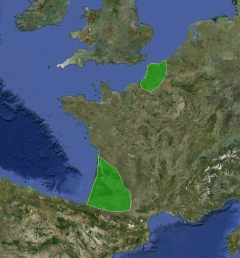 Fig 4 Revolt of the Mordini ( Pas de Calais) And the Aquitani(Bordeaux and Les Landes)Octavian was, initially however, not well known in Gaul. in Consequence on the northern side of the Pyrenees between BC 27 and BC 13, six legions were permanently occupied dealing with non stop revolts in Gaul. Two of the major conflicts were with the Morini and the Aquitani. Historians generally have blamed the widespread convicts as a by product of the imposition of roman taxation but it is also possible that the Gauls were testing Octavian. In the end Octavian did what his experience in Hispania told him he must do. In BC 16 he took personal charge of the pacification of Gaul
Fig 4 Revolt of the Mordini ( Pas de Calais) And the Aquitani(Bordeaux and Les Landes)Octavian was, initially however, not well known in Gaul. in Consequence on the northern side of the Pyrenees between BC 27 and BC 13, six legions were permanently occupied dealing with non stop revolts in Gaul. Two of the major conflicts were with the Morini and the Aquitani. Historians generally have blamed the widespread convicts as a by product of the imposition of roman taxation but it is also possible that the Gauls were testing Octavian. In the end Octavian did what his experience in Hispania told him he must do. In BC 16 he took personal charge of the pacification of Gaul
The Three Gauls
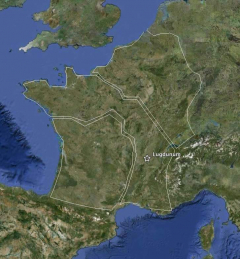 Fig 5 Gallia Belgica ( top right) Gallia Lugdunumensis and Gallia AquitaniaThe Celts behaved like spoilt children, demanding attention and when they did not get it collectively stamping their feet. There was a low level revolt in BC 12 again triggered by a census and the realisation that the main purpose of the census was to formalise the raising of taxes. Octavian dealt with this not by force of arms but by the creation of the Sanctuary of the Three Gauls. .
Fig 5 Gallia Belgica ( top right) Gallia Lugdunumensis and Gallia AquitaniaThe Celts behaved like spoilt children, demanding attention and when they did not get it collectively stamping their feet. There was a low level revolt in BC 12 again triggered by a census and the realisation that the main purpose of the census was to formalise the raising of taxes. Octavian dealt with this not by force of arms but by the creation of the Sanctuary of the Three Gauls. .
The Temple
 Fig 6 The temple of the Three Gauls.This was not simply a temple ( to the Gaulish god Lugh, God of the sun and equated with the roman god Sol Invictus and with Octavian himself. The altar was inscribed with the names of every Gaulish tribe and inaugural priest was a Gaul. Thus Gaul and the celtic tribes were given a special position in the Roman Empire. Octavian’s step sons Tiberius and Drusus were present during the inauguration. Drusus’ wife Antonia gave birth to their son, Claudius in Lugdinium (today’s Lyon) on the same day as the inauguration..
Fig 6 The temple of the Three Gauls.This was not simply a temple ( to the Gaulish god Lugh, God of the sun and equated with the roman god Sol Invictus and with Octavian himself. The altar was inscribed with the names of every Gaulish tribe and inaugural priest was a Gaul. Thus Gaul and the celtic tribes were given a special position in the Roman Empire. Octavian’s step sons Tiberius and Drusus were present during the inauguration. Drusus’ wife Antonia gave birth to their son, Claudius in Lugdinium (today’s Lyon) on the same day as the inauguration..
The first Comes
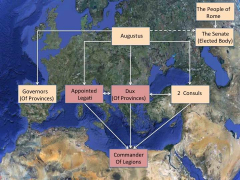 Fig 7 The shift of power for provincial appointments. the first ComesOctavian then went on to alter the structure of the legions. Up to this point in time legions had been raised by Govenors, to meet the needs of specific campaigns or even by rich patricians. Legions had a life of their own and once raised they were rarely disbanded and their allegiances were difficult to control. Octavian reduced the number of from 50 to 28. In AD 9 after three legions were destroyed in a germanic ambush in the Teutoburg forest they were never replaced, thereby reducing the number of Legions to 25. The role of Nobiles Comitas may have existed in some previous format but it was during the reign of Augustus that they were often given the role of commanding a Legion and of legatus. The continued to use the same titles but become became known as the emperors appointees . In military matters in allprovinces outside Italy and Africa the govenors were sidelined.
Fig 7 The shift of power for provincial appointments. the first ComesOctavian then went on to alter the structure of the legions. Up to this point in time legions had been raised by Govenors, to meet the needs of specific campaigns or even by rich patricians. Legions had a life of their own and once raised they were rarely disbanded and their allegiances were difficult to control. Octavian reduced the number of from 50 to 28. In AD 9 after three legions were destroyed in a germanic ambush in the Teutoburg forest they were never replaced, thereby reducing the number of Legions to 25. The role of Nobiles Comitas may have existed in some previous format but it was during the reign of Augustus that they were often given the role of commanding a Legion and of legatus. The continued to use the same titles but become became known as the emperors appointees . In military matters in allprovinces outside Italy and Africa the govenors were sidelined.
Drusus
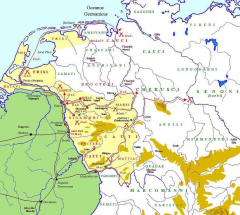 Fig 8 Drusus in GermanyDespite Octavian’s success the Celts were never totally comfortable with the situation in which the Emperor chose his successor without reference to the people and without the demonstrating his military strength. If a son or even a daughter succeeded a father it would possibly have been acceptable to the Celts, but in Rome it was never that simple . Tiberius and Drusus were brothers, both supposedly step sons of Octavian. However there was a belief that Octavian was Drusus’ biological father. Drusus was born after his mother Livia Druscilla had divorced her first husband and married Octavian. Significantly Drusus preferred life in Gaul to life in Rome. He distinguished himself by consolidating the Rhine frontier. For the Celts Drusus became the only acceptable successor to Octavian. He died in a fall from a horse in 9BC and in the eyes of the Celts the succession should have passed to his son Germanicus.
Fig 8 Drusus in GermanyDespite Octavian’s success the Celts were never totally comfortable with the situation in which the Emperor chose his successor without reference to the people and without the demonstrating his military strength. If a son or even a daughter succeeded a father it would possibly have been acceptable to the Celts, but in Rome it was never that simple . Tiberius and Drusus were brothers, both supposedly step sons of Octavian. However there was a belief that Octavian was Drusus’ biological father. Drusus was born after his mother Livia Druscilla had divorced her first husband and married Octavian. Significantly Drusus preferred life in Gaul to life in Rome. He distinguished himself by consolidating the Rhine frontier. For the Celts Drusus became the only acceptable successor to Octavian. He died in a fall from a horse in 9BC and in the eyes of the Celts the succession should have passed to his son Germanicus.
Tiberius
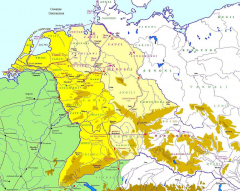 Fig 9 Tiberius on the DanubeWhen Octavian died in 14 AD he nominated Tiberius as Emporer and this was approved by the senate. Tiberius had an excellent military record but his achievements were mainly in the east against the Parthians and on the Danube frontier against the “estern celts. He had a relatively low profile in Gaul and Hispania.
Fig 9 Tiberius on the DanubeWhen Octavian died in 14 AD he nominated Tiberius as Emporer and this was approved by the senate. Tiberius had an excellent military record but his achievements were mainly in the east against the Parthians and on the Danube frontier against the “estern celts. He had a relatively low profile in Gaul and Hispania.
Germanicus
 Fig 10 The Caliga hence CaligulaThe Rhine legions, now with a good representation of Celts in their ranks, objected to Tiberius appointment and called for their commander Germanicus, son of Drusus to be made Emporer. Germanicus himself diffused the situation by leading his army across the Rhine, driving the many Germanic tribes back beyond the Elbe. This in turn made Germanicus a legend amongst the Gallic tribes and the pressure to make him Emperor increased. On his campaigns Germanicus was often accompanied by his son Gaius who became known as Caligula because of the minature copy of Caliga, the soldiers boot, which he wore.
Fig 10 The Caliga hence CaligulaThe Rhine legions, now with a good representation of Celts in their ranks, objected to Tiberius appointment and called for their commander Germanicus, son of Drusus to be made Emporer. Germanicus himself diffused the situation by leading his army across the Rhine, driving the many Germanic tribes back beyond the Elbe. This in turn made Germanicus a legend amongst the Gallic tribes and the pressure to make him Emperor increased. On his campaigns Germanicus was often accompanied by his son Gaius who became known as Caligula because of the minature copy of Caliga, the soldiers boot, which he wore.
Julius Sacrovir
.
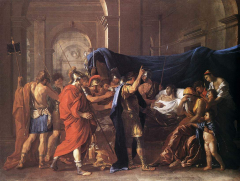 Fig 11 The Death of Germanicus by Nicholas Poussin.[/tab]Germanicus made his home at Augusta Teverorum, subsequently know as Trier. Tiberius recalled Germanicus from Gaul and sent him east, possibly to decrease his influence in the Celtic lands. In the east Germanicus made an unathorised visit to Egypt and shortly afterwards dismissed the Govenor of Syria. A short time afterwards in AD19 he died suddenly, in suspicious circumstances. Popular opinion was that Tiberius was implicated in the murder of Germanicus. The result was another Gaulish revolt and whisperings of support from the Celts in Hispania. The leaders of this revolt included Julius Flores and Julius Sacrovir, Roman citizens. They were fighting against domination from Rome. They were defeated but achieved some of their of their aims. The Treveri, the local gallic tribe based around Trier were given a measure of independance including their own senate. Other Celtic tribes watched with interest.
Fig 11 The Death of Germanicus by Nicholas Poussin.[/tab]Germanicus made his home at Augusta Teverorum, subsequently know as Trier. Tiberius recalled Germanicus from Gaul and sent him east, possibly to decrease his influence in the Celtic lands. In the east Germanicus made an unathorised visit to Egypt and shortly afterwards dismissed the Govenor of Syria. A short time afterwards in AD19 he died suddenly, in suspicious circumstances. Popular opinion was that Tiberius was implicated in the murder of Germanicus. The result was another Gaulish revolt and whisperings of support from the Celts in Hispania. The leaders of this revolt included Julius Flores and Julius Sacrovir, Roman citizens. They were fighting against domination from Rome. They were defeated but achieved some of their of their aims. The Treveri, the local gallic tribe based around Trier were given a measure of independance including their own senate. Other Celtic tribes watched with interest.
